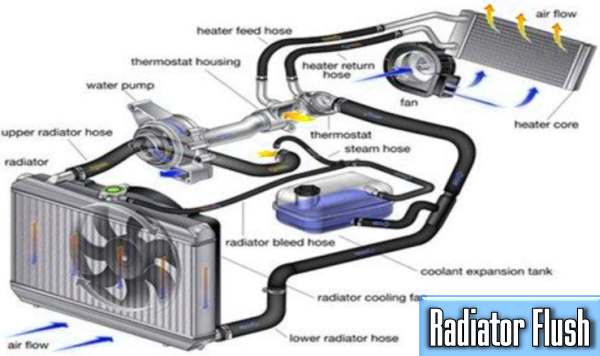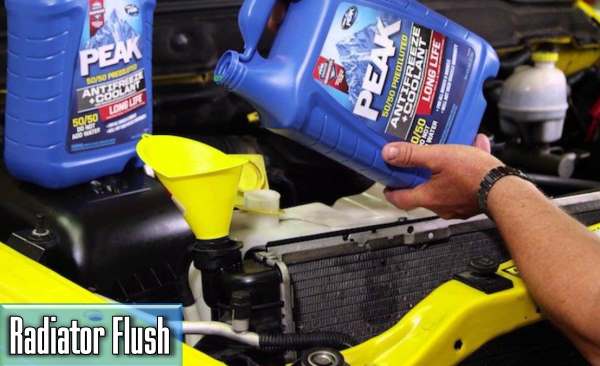You will often notice a car cooling off on the side of the street with smoke coming from the car’s hood. The reason is obvious; an overheated engine, which is often caused due to a problem in the car’s cooling system.
Your car’s radiator transports coolant to the engine to prevent the engine from overheating.
If the radiator gets clogged due to any rhyme or reason, it will fail to do its job well, ultimately leading to an overheated engine. This should tell you why the radiator should be running smoothly at all times. For the radiator to run smooth and clean, it needs to be flushed periodically.
This brings us to the next question, what do you mean by a radiator flush?
Understanding Radiator Flush in Detail:
A radiator flush, also known as a coolant flush, is the process of eliminating dust, rust, sediment, and other harmful particles from the cooling system.
Basically, a radiator flush involves forcing numerous gallons of water, cleaner, and new antifreeze into the cooling system to get rid of all the contaminants that may have built upon it since the last coolant flush.
Believe it or not, it’s one of the most important tasks that a car owner needs to perform to prevent the engine from overheating, and, of course, to extend the car’s life. As such, a radiator flush offers many benefits, which are discussed below in detail.
Advantages of Radiator Flush:
Improves Engine’s Efficiency
As described earlier, the radiator forces coolant into the engine. Subsequently, it prevents the engine from overheating. Plus, it saves your car’s engine from getting clogged with rust, dirt, debris, and sediments.

Improves Functioning of the Cooling System
A radiator flush is a must to keep the cooling system running smoothly at all times. Without a timely radiator flush, the cooling system will get filled with dirt and debris, which would prevent the cooling system from running properly.
Improve the Vehicle’s Lifespan
Allowing your car to run for many years and beyond without a radiator flush can lead to a lot of unnecessary build-up and blockages, which will definitely affect your drivability. The chances are that you will also see its negative impact on the car’s mileage.
Other Benefits:
A radiator flush lubricates and safeguards the seals and water pump. Better still, it ensures that you don’t void the car warranty by helping you keep up with the maintenance standards.
What is the Recommended Frequency for a Radiator Flush?
The best way to determine the recommended frequency of a radiator flush is to have a look at the instruction manual. Generally speaking, most car manufacturers recommend a radiator flush once every five years or every 100,000 miles, whichever comes first.
That said, you might feel the need for a radiator flush sooner than the recommended interval, based on certain factors, such as your driving habits and the conditions under which the car is driven.
In fact, most auto mechanics will recommend that you flush the radiator every 30,000 to 40,000 miles. Of course, you need to pay heed to potential signs that may signal you to flush out the radiator.
The Average Price Of Flushing Car Radiator
Frankly speaking, flushing a radiator is not an expensive procedure. Depending on your car model, it will cost you anywhere between $70 to $130. Most of the cost will go towards the purchase of a new coolant, distilled water, and flushing agent.
| Auto Center | Price |
|---|---|
| NAPA | $80 – $125 |
| Walmart | $70– $105 |
| Mr. Tire | $85 – $130 |
| Midas | $75 – $115 |
Generally, less reputable shops charge lesser than well-known shops. Hence, you can see a price gap of around $50. That said, the price also fluctuates based on the amount of coolant your car will need. On average, most cars need about four gallons of coolant for flushing a radiator.
Important Pointer: Keep in mind that it’s essential to shop for the right coolant for your car because different coolants are available these days, which are specifically designed for specific cars. If you don’t use the right coolant, it will impair the performance of other additives, which can ultimately lead to damage and corrosion.
Radiator Flush Procedure Explained:
The radiator needs to be drained of the old engine first. But then, the work cannot be commenced until the engine is allowed to cool down completely. Touching a warm engine carries the risk of injury.

- Typically, it takes around thirty minutes for the engine to cool down sufficiently. That said, the engine cooldown can sometimes take a few hours, depending on the weather conditions.
- Once the engine has cooled down, the car will be jacked up (from the front) to gain access to the bottom part of the radiator, which will help to get rid of the bubbles from the coolant during the flush.
- The fins of the radiator will be cleared of all the dirt and debris. The radiator will also be inspected for rust or damage, which may be a signal of a more serious issue.
- Both the radiator hoses that enter the car’s radiator will be checked as well. If they have collapsed, they will disrupt the way the coolant flows through the cooling system.
- A drainage pan will be placed right under the drainage valve of the radiator. You will find the petcock (drain cock) attached to the bottom side of the radiator tank.
- To start draining the coolant into the drainage pan, the petcock will be removed with the use of a screwdriver. This will take care of almost 50% of the coolant present in the car.
- Then, the coolant/water/detergent mixture will be allowed to run through the cooling system. To fully circulate the mixture, the car must run for at least ten to fifteen minutes.
- This mixture will be drained off from the car once the engine cools down sufficiently. This process will be repeated around two to three times to complete the mixture flushing process.
- At this point, the new coolant will be added to the car’s engine. An ideal coolant mix should comprise around 50% coolant and 50% distilled water. This is a standard mixture that works great on most cars.
- Next, the radiator will be bled to remove air pockets. The radiator cap will then be removed, and the engine will be allowed to run for about ten minutes to enable the trapped air to escape. Finally, the coolant will be topped up.
Radiator Flush Cost: How to Save Money?
If you don’t mind doing the repair yourself, you can save some money by flushing the radiator from the comforts of your personal garage. Keep in mind that the coolant is quite toxic by nature. So, make sure to recycle it properly. Most of the local garages will dispose of the coolant for a nominal fee.
If you are getting the job done from a mechanic, have them perform a full inspection of the car’s cooling system to check for potential leaks. If they just flush the radiator without inspecting the leaks, it will lead to an expensive repair down the road.
 Car Service Land Coupons for Oil change, Tires, Wheel alignment, Brakes, Maintenance
Car Service Land Coupons for Oil change, Tires, Wheel alignment, Brakes, Maintenance